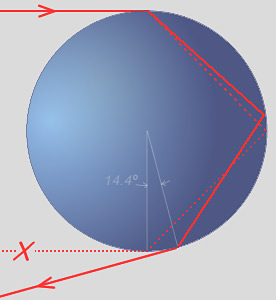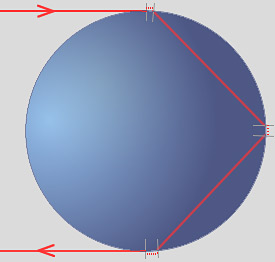

|
A
glory is directly opposite the sun and has a bright centre whose
light is strongly polarised. These observations tell us that droplets
somehow deflect light through angles of around 180º and that
at least one internal reflection is involved.
Simple diffraction theory fails to explain the glory or the positions
of its rings. Rigorous Mie scattering theory, as used in IRIS,
predicts the glory perfectly. But gives gives no clues to how it forms.
Mie theory - formulated at a fundamental level from Maxwell's equations
of electromagnetism - says only what happens and not how.
Fortunately, a reformulation of Mie theory made by Peter Debye,
reveals more. The major source of the glory's central illumination
is light reflected once inside droplets. There are lesser
contributions from light reflected 10, 6 and 5 times. Philip Laven
provides an excellent
account of the application of Debye theory to light scattering
by water drops.
Impossible ray path? The dotted ray with one reflection shown
at upper left is impossible! Water does not refract strongly enough.
The actual path, drawn as a solid line for red light, leaves the
droplet 14.4º short of the demanded 180º. Paths
entering the sphere in other positions also fail to explain the
glory. Diffraction in small droplets eliminates the sharp ray paths
but does not solve the problem.
How do we explain the apparently impossible light path? We can do so by
taking account of another optical phenomenon in addition to reflection,
refraction and diffraction -- surface waves.
The incoming ray at left grazes the droplet surface. Under these
conditions it can travel along the rim as a "surface wave"
before being refracted. At the internal reflection the grazing incidence
condition still holds and the reflection can be delayed. A third
delay can take place as the light exits. The surface waves are shown
schematically at left as red dotted lines.
 |
Surface waves are strongest for light at grazing incidence, i.e.when
the ray shown at right is refracted so that it would leave the denser
medium parallel to the surface. The surface wave can, after a delay,
form a displaced and weaker internally reflected beam. Surface waves
decay very rapidly but for a 10µm dia. droplet the total path
length required is less than 1µm or 1-2 wavelengths.
There are other interpretations. Any mystery is of our making in that we often seek explanations for the world in terms of our everyday or macro experience and these do not exist for the glory. Nonetheless, the physics of Maxwell is fully able to account for it.
|




